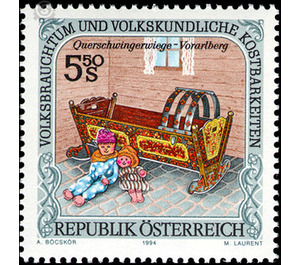folklore - Austria / II. Republic of Austria 1994 - 5.50 Shilling
Theme: Art & Culture
| Country | Austria / II. Republic of Austria |
| Issue Date | 1994 |
| Face Value | 5.50 |
| Color | multi-colored grey |
| Printing Type | combination printing |
| Stamp Type | Commemorative |
| Item Type | Stamp |
| Chronological Issue Number | 1458 |
| Chronological Chapter | OOS-OE2 |
| SID | 5149 |
| In 65 Wishlists | |
In order to facilitate difficult sleepy children the way into the realm of dreams, already recommends the Greek philosopher Plato (5./4.Jhd.v.Chr.) Rhythmic rocking movement. The emergence of the cradle as a commodity has its roots in hollowed out tree trunks, from which ever more complex forms have been developed. The oldest, well preserved wooden cradle with skids is known to us from Herculaneum, not far from Pompeii, in Italy (about 79 AD). The illustrated cradle with cradle bow from Dornbirn, the largest city in Vorarlberg today, is one of the "transverse rocker weigh" and thus also to the "skid-type cradles and skids weighing". It dates from 1808 and is a particularly impressive example of this children's furniture, which is also widely used in Austria, thanks to its colorful paintings and functional details.


